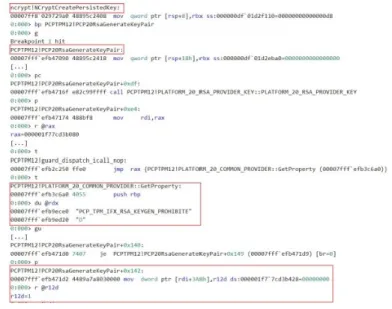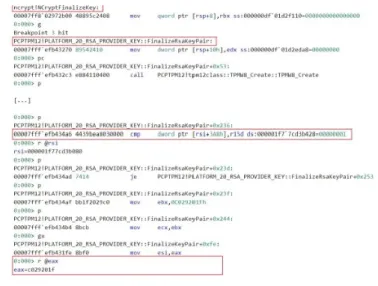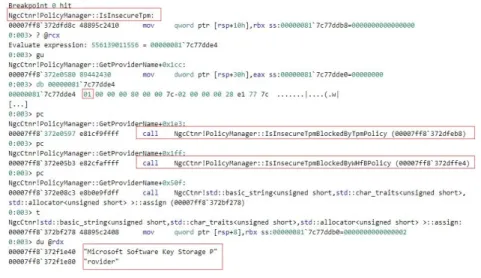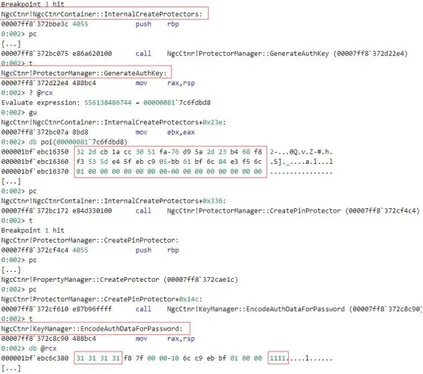HAL Id: hal-03088319
https://hal.archives-ouvertes.fr/hal-03088319
Submitted on 26 Dec 2020
HAL is a multi-disciplinary open access
archive for the deposit and dissemination of
sci-entific research documents, whether they are
pub-lished or not. The documents may come from
teaching and research institutions in France or
abroad, or from public or private research centers.
L’archive ouverte pluridisciplinaire HAL, est
destinée au dépôt et à la diffusion de documents
scientifiques de niveau recherche, publiés ou non,
émanant des établissements d’enseignement et de
recherche français ou étrangers, des laboratoires
publics ou privés.
Distributed under a Creative Commons Attribution - NonCommercial - NoDerivatives| 4.0
International License
The TPM: Technical Overview of Microsoft’s Interim
Measures against CVE-2017-15361
Aleksandar Milenkoski
To cite this version:
Aleksandar Milenkoski. The TPM: Technical Overview of Microsoft’s Interim Measures against
CVE-2017-15361. [Technical Report] ERNW Enno Rey Netzwerke GmbH. 2020. �hal-03088319�
The TPM: Technical Overview of Microsoft’s Interim Measures
against CVE-2017-15361
Aleksandar Milenkoski)
amilenkoski@ernw.de
This work is part of the Windows Insight series. This series aims to assist efforts on analysing inner working principles, functionalities, and properties of the Microsoft Windows operating system. For general inquiries contact Aleksandar Milenkoski (amilenkoski@ernw.de) or Dominik Phillips (dphillips@ernw.de). For inquiries on this work contact the corresponding author ()).
The content of this work has been created in the course of the project named ’Studie zu Systemaufbau, Protokollierung, Härtung und Sicherheitsfunktionen in Windows 10 (SiSyPHuS Win10)’ (ger.) - ’Study of system design, logging, hard-ening, and security functions in Windows 10’ (eng.). This project has been contracted by the German Federal Office for Information Security (ger., Bundesamt für Sicherheit in der Informationstechnik - BSI).
Required Reading
In addition to referenced work, related work focussing on the Trusted Platform Module (TPM), part of the
Win-dows Insight series, are relevant for understanding concepts and terms mentioned in this document.
Technology Domain
The operating system in focus is Windows 10, build 1607, 64-bit, long-term servicing branch (LTSB). The TPM standard in focus is version 2.0.
1 Introduction
This document provides a technical overview of Microsoft’s interim measures against a vulnerability in Trusted Platform Module (TPM) chipsets manufactured by Infineon ([Common Vulnerabilities and Exposures] CVE-2017-15361).1 This vulnerability affects the generation of Rivest–Shamir–Adleman (RSA) keys by vulnerable TPM
chipsets making keys susceptible to the Return of Coppersmith’s attack (ROCA). This attack enables attackers to recover the private key from the public key of a weak public-private key pair. The CVE-2017-15361 vulnerability is a firmware vulnerability, and not a vulnerability in the operating system. However, because of its criticality, Microsoft has implemented interim measures against this vulnerability until firmware vendors provide a patch addressing it. These measures are implemented as part of the KB4041691 update for the Windows version that is in the focus of this work.2
1https://nvd.nist.gov/vuln/detail/CVE-2017-15361 [Retrieved: 17/12/2019]
2https://support.microsoft.com/en-us/help/4041691/windows-10-update-kb4041691 [Retrieved: 17/12/2019]
amilenkoski.client.ernw.net 2020-05-29 13:50:19
Among other things, the KB4041691 update modifies Windows 10 such that it prevents the generation of weak RSA keys by the TPM and generates EventLog log entries when a vulnerable TPM chipset is detected.3 In
summary, the KB4041691 update:
• introduces in the ncrypt library the PCP_TPM_IFX_RSA_KEYGEN_PROHIBITED and
PCP_TPM_IFX_RSA_-KEYGEN_VULNERABILITY properties of the provider named Platform Cryptographic Provider. This provider,
characterized by named properties, abstracts the TPM device and is used by applications as an abstraction layer for communicating with the TPM. The PCP_TPM_IFX_RSA_KEYGEN_PROHIBITED property enables system administrators to prohibit the generation of weak RSA keys by a vulnerable TPM chipset at system-level by setting the registry value
HKEY_LOCAL_MACHINE\Software\Policies\Microsoft\Tpm\IFX_VULNERA-BLE_RSA_KEY_GEN_PROHIBITED to 0x1. The PCP_TPM_IFX_RSA_KEYGEN_VULNERABILITY property
en-ables applications to detect vulnerable TPM chipsets and react appropriately, independently of system configuration. This may involve, for example, generating keys in software instead of hardware (i.e., by the TPM);
• implements the generation of an EventLog log entry with an ID of 1794 when the Tpm-Maintenance sched-uled task is executed. This task is executed as part of the TPM provisioning process. If TPM auto-provisioning is enabled, this process is conducted at every system startup.
Section 2 and Section 3 of this work provide more technical information on the points listed above.
It is important to emphasize that in order to fully remediate the CVE-2017-15361 vulnerability, users have to install the firmware update provided by the hardware original equipment manufacturer (OEM) for patching the vulnerability. In addition, users have to clear and re-provision the TPM. This may render software that uses TPM-generated keys unstable and may lead to loss of TPM-protected data. Therefore, users have to make in advance remediation plans for such software and data. This includes, for example, a temporary transition to the use of software-generated keys. After the TPM has been re-provisioned, users may generate new keys with it and re-enroll software that uses TPM-generated keys and data that needs to be protected by the TPM.
2 Generation of RSA keys
Windows 10 provides the Cryptography API: Next Generation (CNG) library as an abstraction layer for com-municating with the TPM. CNG uses the concept of cryptographic providers, where providers are entities per-forming cryptographic operations (e.g., hashing, digital signature verification). There are two main types of CNG providers: algorithm and key storage providers. The former are used for performing basic cryptographic operations, such as hashing and signing, whereas the latter are used for performing key operations, such as creating and storing keys. CNG abstracts the TPM device in the form of a cryptographic provider, referred to as the Platform Cryptographic Provider.
Each key storage provider is characterized by named provider properties. Applications may obtain the value of a given property by invoking the NCryptGetProperty function,4specifying the name of the property as the function’s
second parameter.
The KB4041691 update introduces two new properties of the Platform Cryptographic Provider:
PCP_TPM_IFX_-RSA_KEYGEN_PROHIBITED and PCP_TPM_IFX_RSA_KEYGEN_VULNERABILITY. For TPMs of version 2.0, these
provider properties are implemented in the PLATFORM_20_COMMON_PROVIDER::GetProperty function, in the
PCPTpm12.dll library file. This library file is part of the CNG functionalities related to the TPM.
The PCP_TPM_IFX_RSA_KEYGEN_VULNERABILITY property is used for detecting vulnerable versions of TPM chipsets;5 that is, this property is set if a vulnerable TPM chipset is deployed. The
IsIFXRSAKeyGenVulnerabil-ityAffected function, implemented in PCPTpm12.dll, identifies vulnerable versions of TPM chipsets.
3https://portal.msrc.microsoft.com/en-us/security-guidance/advisory/ADV170012 [Retrieved: 17/12/2019] 4https://docs.microsoft.com/en-us/windows/win32/api/ncrypt/nf-ncrypt-ncryptgetproperty [Retrieved: 17/12/2019] 5https://nvd.nist.gov/vuln/detail/CVE-2017-15361 [Retrieved: 17/12/2019]
The PCP_TPM_IFX_RSA_KEYGEN_PROHIBITED property is used for system administrators to configure Windows 10 to prohibit the generation of weak RSA keys. This property is set if the registry value
HKEY_LOCAL_MA-CHINE\Software\Policies\Microsoft\Tpm\IFX_VULNERABLE_RSA_KEY_GEN_PROHIBITED is set to 0x1. The
evalu-ation of this registry value is performed by the IsIFXRSAVulnerabilityKeyGenProhibitedByPolicy function, imple-mented in PCPTpm12.dll (see Figure 1). The setting of the registry value prohibits the generation of RSA keys by vulnerable TPMs at system-level. We observed that this value is not set by default when the KB4041691 update is applied.
Figure 1: Evaluation of the registry value HKEY_LOCAL_MACHINE\Software\Policies\Microsoft\Tpm\IFX_VUL-NERABLE_RSA_KEY_GEN_PROHIBITED
Figure 2: Operation of NCryptCreatePersistedKey and PCP20RsaGenerateKeyPair
Next, we discuss how the PCP_TPM_IFX_RSA_KEYGEN_PROHIBITED property prohibits the generation of weak RSA keys. In order to observe the impact of this property, we attempted to generate an RSA key using the
Platform Cryptographic Provider (i.e., the TPM) with the PCPTool.6
Applications invoke the NCryptCreatePersistedKey function, part of the ncrypt library (library file: ncrypt.dll), to instruct the TPM to generate an RSA key.7 In the context of the ncrypt library, keys are represented as key
ob-jects. NCryptCreatePersistedKey invokes the PCP20RsaGenerateKeyPair function implemented in PCPTpm12.dll. The KB4041691 update modifies PCP20RsaGenerateKeyPair such that it generates a key object and invokes the
PLATFORM_20_COMMON_PROVIDER::GetProperty function in order to obtain the value of the
PCP_TPM_IFX_-6https://github.com/microsoft/TSS.MSR/tree/master/PCPTool.v11 [Retrieved: 17/12/2019]
RSA_KEYGEN_PROHIBITED property (see Figure 2). If the property is set, PCP20RsaGenerateKeyPair sets the
offset 0x3A8 of the generated key object to 1. This indicates that the generation of weak RSA keys is prohibited.
Figure 3: Operation of NCryptFinalizeKey and FinalizeRsaKeyPair
Applications must invoke the NCryptFinalizeKey function, also part of the ncrypt library, such that a key generated by NCryptCreatePersistedKey is completed and ready for use.8 When a TPM of version 2.0 has been instructed
to generate an RSA key, NCryptFinalizeKey invokes the PLATFORM_20_RSA_PROVIDER_KEY::FinalizeRsaKeyPair function implemented in PCPTpm12.dll (see Figure 3). This function evaluates the value stored at the offset
0x3A8 of the key object generated by NCryptCreatePersistedKey. If this value is 1, FinalizeRsaKeyPair does not
fi-nalize the key and returns the status (error) code 0xC029201f (STATUS_PCP_IFX_RSA_KEY_CREATION_BLOCKED, function return values are stored in the rax register, see Figure 3). This effectively prohibits the generation of RSA keys by the TPM if the registry value
HKEY_LOCAL_MACHINE\Software\Policies\Microsoft\Tpm\IFX_VULNER-ABLE_RSA_KEY_GEN_PROHIBITED is set to 0x1. Figure 4 depicts the definition of the status code 0xC029201f
implemented in ntstatus.h, a library header file distributed as part of Microsoft’s Software Development Kit (SDK).
Figure 4: Definition of the status code STATUS_PCP_IFX_RSA_KEY_CREATION_BLOCKED
This section shows that the KB4041691 update, by introducing the PCP_TPM_IFX_RSA_KEYGEN_PROHIBITED and PCP_TPM_IFX_RSA_KEYGEN_VULNERABILITY provider properties in the ncrypt library, enables applications to detect vulnerable TPM chipsets and system administrators to prohibit the generation of weak RSA keys at system-level. If the generation of weak RSA keys is not explicitly prohibited by administrators, applications may use thePCP_TPM_IFX_RSA_KEYGEN_VULNERABILITY property to detect vulnerable TPM chipsets and react ap-propriately, independently of system configuration. This may involve, for example, generating keys in software instead of hardware (i.e., by the TPM). The KB4041691 update introduces such changes to applications devel-oped by Microsoft and distributed with Windows 10. Section 2.1 shows how the Windows Hello component of Windows 10 addresses the generation of weak RSA keys by the TPM.
2.1 Windows Hello
The Windows Hello component of Windows 10 enables users to authenticate themselves using biometric data or PIN. The PIN can be bound to the TPM and hence to the device where the PIN is generated. Therefore, for an attacker to compromise a PIN-protected Windows account set on a given device, the attacker would have to know the account’s PIN and to have physical access to the device itself.9
If a TPM is available, Windows Hello (if not explicitly configured otherwise) will use the TPM to bind the PIN to the TPM through a process called TPM sealing. This process involves encrypting data using a private key protected by the TPM (i.e., stored in the TPM or wrapped by the TPM) and taking the state of the TPM’s Platform Configuration Registers (PCRs) into account.10 Encrypted data may then be decrypted only by the TPM device
that has encrypted it and only if the PCR states match. Windows Hello binds a PIN to a TPM such that the TPM seals a randomly generated sequence, referred to as authentication key in this work, using the PIN as a decryption (unsealing) passphrase. When a user attempts to log in using a PIN, the PIN is used for the TPM to unseal the authentication key. If the unsealing process succeeds, which implies that the PIN is correct, the user is logged in. This ensures that the PIN-based login process takes place at the device where the PIN has been created.
The Microsoft Passport Container service, with functionalities implemented in the NgcCtnr.dll library file, man-ages the PIN-based login process. The KB4041691 update modifies the PolicyManager::GetProviderName func-tion, implemented in NgcCtnr.dll, such that it invokes:
• the PolicyManager::IsInsecureTpm function, which evaluates the value of the
PCP_TPM_IFX_RSA_KEYGEN_-VULNERABILITY property (see Section 2);
• the PolicyManager::IsInsecureTpmBlockedByTpmPolicy function, which evaluates the value of the
PCP_-TPM_IFX_RSA_KEYGEN_PROHIBITED property (see Section 2); and
• the PolicyManager::IsInsecureTpmBlockedByWHfBPolicy function, which evaluates the registry value
HKEY_-LOCAL_MACHINE\System\CurrentControlSet\Control\Cryptography\NGC\InsecureTPM; this is a Windows
Hello-specific configuration interface for prohibiting Windows Hello to use vulnerable TPM chipsets.
If the first parameter of one of these functions is set to 0x1, Windows Hello is configured to use a software-based cryptographic provider, that is, the Microsoft Software Key Storage Provider11– this indicates that the TPM chipset
is vulnerable or its use has been prohibited by a system administrator (see Section 2). If the first parameter of all of these functions is set to 0x0, Windows Hello is configured to use the TPM, that is the Platform Cryptographic
Provider.
Figure 5 depicts relevant aspects of the workflow of the PolicyManager::GetProviderName function when exe-cuted on a device with a vulnerable TPM chipset. The first parameter of PolicyManager::IsInsecureTpm is set to
0x1, and therefore, Windows Hello is configured to use the Microsoft Software Key Storage provider.
Figure 6 depicts relevant aspects of the workflow of the PolicyManager::GetProviderName function when exe-cuted on the same device, however, in a scenario where the value of the first parameter of PolicyManager::IsInsecureTpm has been manually changed (patched) to 0x0 and the generation of weak RSA keys has not been prohibited. This indicates that the TPM chipset is not affected by CVE-2017-15361. Therefore, Windows Hello is configured to use the TPM, that is, the Platform Cryptographic Provider (Microsoft Platform Crypto Provider in Figure 6). If Windows Hello is configured to use the Platform Cryptographic Provider, when a user configures a new PIN, it binds the PIN to the TPM by sealing a previously generated authentication key specifying the PIN as a decryption (unsealing) passphrase. Figure 7, Figure 8, and Figure 9 depict relevant aspects of this process.
9https://docs.microsoft.com/en-us/windows/security/identity-protection/hello-for-business/hello-why-pin-is-better-than-password
[Retrieved: 17/12/2019]
10https://docs.microsoft.com/en-us/windows/security/information-protection/tpm/switch-pcr-banks-on-tpm-2-0-devices [Retrieved:
17/12/2019]
Figure 5: Workflow of PolicyManager::GetProviderName (vulnerable TPM chipset)
Figure 6: Workflow of PolicyManager::GetProviderName (non-vulnerable TPM chipset)
The NgcCtnrContainer::InternalCreateProtectors function, implemented in NgcCtnr.dll, invokes the
ProtectorMan-ager::GenerateAuthKey function. This function generates the authentication key (the sequence starting with 32 2d cb 1a .. in Figure 7). Once the authentication key is generated, the KeyManager::EncodeAuthDataForPassword
function encodes the user-provided PIN (1111 in Figure 7) so that it can be used as a decryption passphrase. Then, the ProtectorManager::_PackUserAuthBlob function modifies the format of the authentication key to pre-pare it for sealing (the sequence starting with 20 00 00 00 32 2d cb ... in Figure 8).
Figure 7: Binding a PIN to a device (part 1)
Once the authentication key is ready for sealing, the HardwareKeyFactory::SealData function invokes the
NCryp-tEncrypt function of the ncrypt library, which conducts the sealing. The first parameter of this function specifies a
key named MICROSOFT_PCP_KSP_RSA_SEAL_KEY_3BD1C4BF-004E-4E2F-8A4D-0BF633DCB074. This key refers to the storage root key (SRK) key, whose private part is stored in, and cannot leave, the TPM. The second param-eter of NCryptEncrypt stores the data to be sealed, that is the modified authentication key (the sequence starting with 20 00 00 00 32 2d cb ... in Figure 8). Finally, the PLATFORM_20_SEAL_PROVIDER::Seal function sends TPM commands to the TPM for sealing the authentication key.
First, the TPM command TPM_CC_ReadPublic, identified by the byte sequence 00 00 01 73 ([Tru16], Section 12.4) obtains the public key of the SRK from the TPM (the byte sequence starting with b9 b2 95 ... in Figure 9). In order to verify that the public key obtained in PLATFORM_20_SEAL_PROVIDER::Seal is that of the SRK, we extracted the public key of the SRK using the PCPTool utility, which displayed the same byte sequence (the byte sequence starting with b9 b2 95 ... in Figure 10). Using the SRK’s public key, PLATFORM_20_SEAL_PROVIDER::Seal en-crypts, that is, seals, the data by issuing the TPM_CC_Create TPM command, identified by the byte sequence 00
00 01 53 (see Figure 9, [Tru16], Section 12.1).
Figure 9: Binding a PIN to a device (part 3)
3 Generation of EventLog Log Entries
The KB4041691 update modifies Windows 10 such that it generates an EventLog log entry with the ID 1794 in the
Windows Logs/System event logging channel.12 The entry indicates that a vulnerable TPM chipset is deployed
on the device where the entry has been generated. This helps system administrators to detect the presence of a vulnerable TPM chipset in a straightforward manner.
The log entry with ID 1794 is generated by the TpmCheckIFXRSAKeyGenVulnerability function, implemented in the TpmCoreProvisioning.dll library file. TpmCheckIFXRSAKeyGenVulnerability is invoked by the
CTpmTasksHan-dler::Worker function, implemented in the TpmTasks.dll library file. CTpmTasksHanCTpmTasksHan-dler::Worker is invoked when
the Tpm-Maintenance scheduled task is executed. This task is executed as part of the TPM auto-provisioning process. If TPM auto-provisioning is enabled, the process is conducted at every system startup.
Figure 11 depicts relevant aspects of the implementation of TpmCheckIFXRSAKeyGenVulnerability.
TpmCheck-IFXRSAKeyGenVulnerability invokes the NCryptGetProperty function in order to obtain the value of the PCP_TPM_-IFX_RSA_KEYGEN_VULNERABILITY property (see Section 2). If this property is set, TpmCheckIFXRSAKeyGenVul-nerability generates an EventLog log entry with an ID of 1794. The metadata describing this log entry is stored
in the variable TPMCOREEVENT_TPM_VULNERABLE_FIRMWARE_DETECTED, implemented in
TpmCoreProvision-ing.dll (see Figure 11). Figure 12 depicts this metadata. The metadata is stored in an _EVENT_DESCRIPTOR
structure that is defined in the context of the ntdll.dll library file.13 The hexadecimal value of the field Id of the
_EVENT_DESCRIPTOR structure is the ID of the log entry (1794 in decimal form).
Figure 11: Workflow of TpmCheckIFXRSAKeyGenVulnerability
Figure 12: The content of TPMCOREEVENT_TPM_VULNERABLE_FIRMWARE_DETECTED
12https://portal.msrc.microsoft.com/en-us/security-guidance/advisory/ADV170012 [Retrieved: 17/12/2019]
13https://docs.microsoft.com/en-us/openspecs/windows_protocols/ms-dtyp/a6110d36-28c1-4290-b79e-26aa95a0b1a0 [Retrieved:
References
[Tru16] Trusted Computing Group (TCG). Trusted Platform Module Library Part 3: Commands. 2016. Family 2.0, Level 00, Revision 01.38; https://trustedcomputinggroup.org/wp-content/uploads/TPM-Rev-2.0-Part-3-Commands-01.38.pdf.




